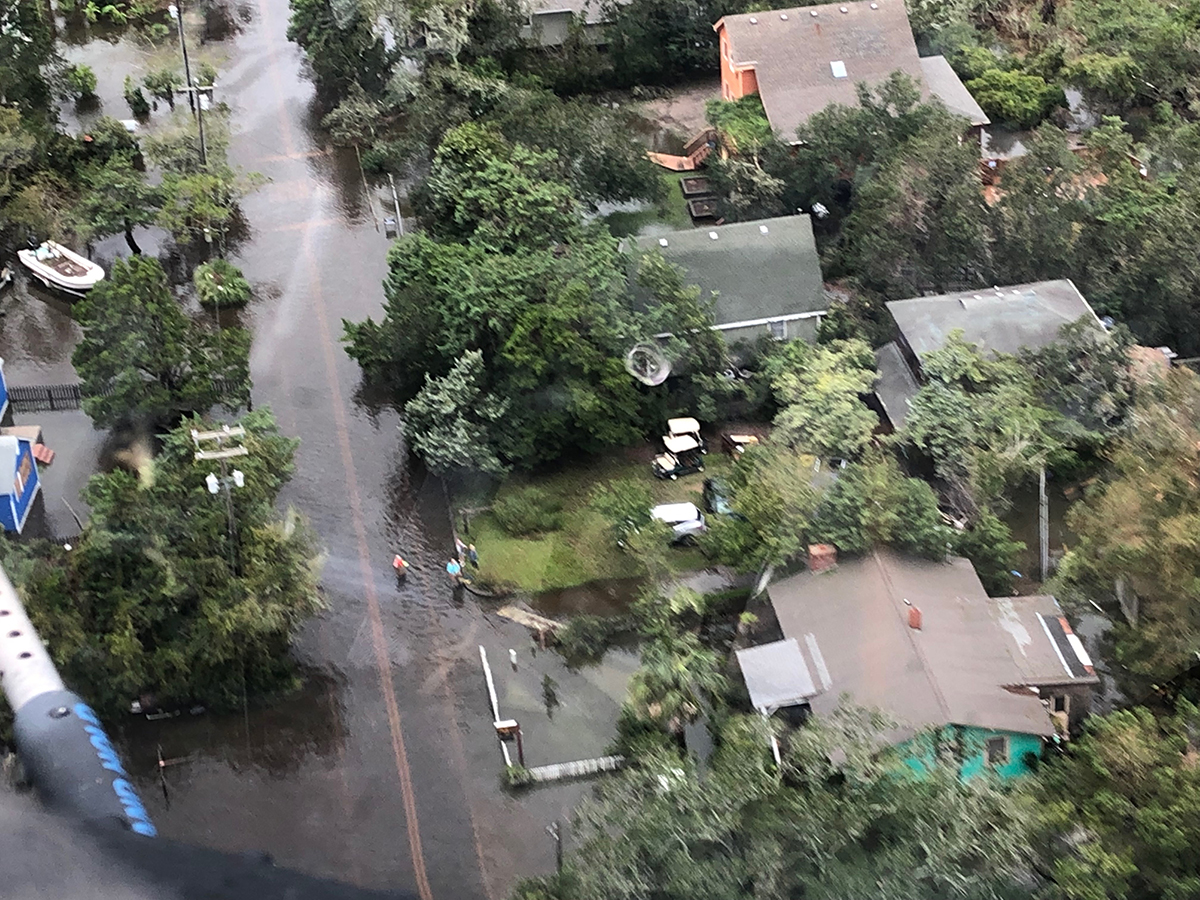
Usually right after a hurricane, dollar estimates of the damage are calculated and reported in the media and in academic and government papers, but the human toll exacted when floodwaters enter or destroy homes cannot be expressed in strictly monetary terms and may not be fully understood.
A collaboration of social and environmental scientists and engineers has been working to better grasp how flooding disasters disrupt people’s day-to-day lives in coastal North Carolina and how these communities respond and rebuild.
Supporter Spotlight
In addition to the economics, the effort, called Dynamics of Extreme Events, People and Places, or DEEPP, is working to gauge the environmental, social and psychological damage that hurricanes and flooding inflict. The goal is to help people in flood-prone areas better prepare and recover.
To accomplish this, DEEPP is piecing together information derived from surveys of families and individuals in affected communities along with satellite photos and flood and storm surge mapping.
The project has focused on select areas within four counties, with communities chosen to represent diverse ecosystems and ecological environments that were also different economically and demographically. Interviewers have been working in the Hatteras area of Dare County, mainland Hyde County and Ocracoke, Beaufort and Down East in Carteret County, including Merrimon and North River, and most recently in New Bern in Craven County.
“Those areas span pretty different places, different kinds of livelihoods, and different degrees of damage from both Florence and Dorian,” said University of North Carolina researcher Dr. Elizabeth Frankenberg, director of the Carolina Population Center and a primary investigator with the DEEPP project. Among her areas of study is how people who survive disasters are changed, including their physical and psychosocial health.

As guest speakers for a recent “Parlor Talk” hosted by the Core Sound Waterfowl Museum and Heritage Center at its Morehead City museum store, Frankenberg and Dr. Nathan Dollar, a social demographer at the Carolina Population Center and project director with the DEEPP household survey, and members of the household survey team discussed their experiences and findings – so far. They said the work is the beginning of a long commitment to these counties and could lead to improved disaster response.
Supporter Spotlight
“Typically, we’re talking about the effect of an extreme weather event in terms of property damage,” Dollar said. “We know less scientifically about how people in communities are affected, how to prepare and how to recover and the complexities and the duration of that recovery.”

Frankenberg said that an early observation, although not a particularly surprising one, is that these coastal areas include a relatively higher number of residents with multigenerational ties to the community, as compared to more urban areas.
“And that has generated, I think, a very deep attachment to place,” she said, adding that the feeling is complicated by residents’ anxiety about the future, with worries such as, “Is this going to be a viable place for my children or my grandchildren to make a living economically?”
“Looking backwards, it’s also clear that these major hurricanes had left scars on people’s economic outlooks and on their health or psychosocial health. Their recovery process is long, and it’s slow, and it’s complicated, and it’s hard to know in what order to do things and where to turn for potential assistance and whether you’re trying to move fast or whether to try to take your time and figure out what might be the best long-term solution for your home or your property,” she said.
Frankenberg said she had a deep connection to the coast, in particular Carteret County, where her father worked at the UNC Institute of Marine Sciences in the 1970s, and that she had long wanted to better understand the area.
“That’s partially because I spent a long time studying the Indian Ocean tsunami in Indonesia, of all places, and got very interested in how water changes landscapes and then ultimately peoples’ lives lived in those landscapes,” she said.
She said the DEEPP project is to learn more about how families go about putting their lives back together after a flood.
“If you read the papers around hurricanes, a lot of effort goes into calculating property damage after big events and how many counties have disaster declarations, but then it quickly kind of drops off the papers. And I know from Indonesia that the process of trying to recover, trying to get your life back together and trying to rebuild what you want to rebuild, and also just thinking about your future, it’s really a months- and yearslong proposition after a really major storm,” Frankenberg said.
Random samples of tax parcel data provide the names and addresses, and DEEPP survey teams then go out to find those addresses and interview the residents. Sometimes, the addresses are long-term nursing care centers, sometimes the residents are homeowners, other times they’re renters. Some are full-time residents, sometimes the addresses are second homes.
“Sometimes, we’ll find that people have moved out. And ideally, we try to find them and understand their decision to move away from a particular place,” Frankenberg said.
Talking to every member of a family is how the researchers are trying to gain a deeper perspective of recovery. The surveys include modules for the entire household but also questions for each member of the household 15 and older.
“So, we get the high schooler’s perspective on missing school and the mom’s perspective on not having daycare or babysitting or disruptions to work, and the dad’s perspective on trying to do the pieces that he’s taking responsibility for,” Frankenberg said. “Ideally, we talk to everybody in the household to collect this information.”
Some who are contacted are willing to talk to the interviewers, others not as much. Dollar said one of the biggest impediments to the success of the project is that people don’t like surveys. “And I don’t blame them. And our survey is not your typical 10-question survey. It takes a while,” he said.
There are also trust and privacy concerns for some, such as mistrust of outsiders coming in asking questions or worry about neighbors knowing their business.
Members of the survey team who were also present at the discussion said many were just happy that someone was willing to listen, that their voices were being heard.
Frankenberg said that the team’s approach was important in breaking down any barriers.
“It’s not so much that people don’t want to talk about the topics that we’re talking about, but it’s how to kind of ease into the interview, as opposed to just a normal conversation. And the more we can make it like a conversation, I feel like the better it goes,” Frankenberg said.
The information collected could have significant implications in terms of preparing for and responding to flooding disasters, the researchers said.
Dollar said that because of the Census Bureau’s undercount in mainly rural areas, the census doesn’t provide reliable information on not only population but also the age breakdown in that area.
“There are some serious significant issues related to aging on the coasts,” Dollar said. “All of these coastal counties are getting older and age is the factor that shapes people’s ability to prepare for and recover from storms. And I’ll say one of the strengths of kind of the household-based, tax parcel, methodological sampling approach is that we have really rich, representative data. We’re going to have a really good picture of what the population looks like in these counties.”
He said a better picture of the demographic composition of coastal counties could be important for planning and emergency preparedness.
“We really hope that data could be useful to the communities themselves,” Dollar said.
He said the researchers had been discussing their findings with officials at the Department of Emergency Management. “They’re very excited about the data that we’re collecting,” he said, adding that state officials were especially interested in “more people-centered emergency management approaches.”







